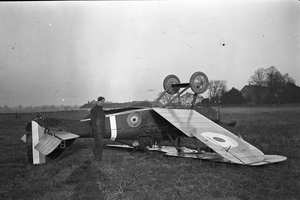[Received February 8, 1918]
#20
Royal Flying Corps,
London Colney,
Jan. 14, 1918
Dear Mother:
Great excitement to report! I received your Christmas box. It contained one suit of underwear, six white and 3 silk tan handkerchiefs, one large box of fudge, one box of Md. B. Co. wafers, some prunes, and the wrapper of a package of lux, one wash cloth and water proof container. Everything was in good condition except the lux which had broken open and sifted all out, but did not get on any of the food except the prunes. It surely was a fine box and is giving great rejoicement.
Comparisons are odious but the underwear was the head liner. It is just exactly right. The nicely marked handkerchiefs are fine and in great demand. The silk ones are very class and go very well with my good uniform. When I find that girl I will get her to embroider my initials on them for me. Of course the fudge is in great demand, and although I have gorged it in great quantities have felt no ill effects.
I received a box from Aunt Ella and Uncle Fred that had a wonderful piece of fruit cake, a can of Whitman’s instananeous cocoa, a box of sugared ginger, and a box of conserve fruit. I believe I told you about Knud’s and Mrs. McQueen’s boxes.
Margaret says Jimmy is going to send me something. Drop her the hint that I need another wash rag 2 ft by 1 ft and the strongest toweling procurable, hemmed, loop of tape, and labeled “Hoops.” I have darned up my other one but it has completely gone now. It should be very strong to stand the wringing.
I have had one real good flight lately. It was on a clear (strange to relate) cold morning. We went up about 6,500 feet and could see all over. I learned a good deal about flying the bus but I am still pretty punk.
We were paid last week, full amount, and I tried to get leave to go to London after my flight, but the adjutant would not let me go because of some impending changes in the assignments of pupils to flying instructors. We busted up three of our five busses the past few days.
Sergeant Springs the cadet who had charge of us on the boat and at Oxford has come here. He has done a lot of flying on Curtisses and after a little on Avros will go to Pups. An American capt. who had done 250 hours flying in the states was here the other day. One of us, cadet Nathan, who had only done 8 hours on Avros took him up and gave him the ride of his life by giving him his first loops, spins, rolls, Immelmans, half rolls, etc.
Lovingly,
Parr.

Md. B. Co. is presumably the Maryland Biscuit Company.
“Herts.” is the abbreviation for Hertfordshire, the county in which Colney lies.
In 1879 Parr’s maternal aunt Ella Parr married Frederick Focke Reese, who in 1908 had been elected Bishop of the Episcopal Diocese of Georgia.230 They were visiting New York and staying at the Collingwood Hotel in Manhattan in the autumn of 1917 when Parr was in Mineola preparing to embark for Europe. Parr looked them up and went out to dinner with them on September 7, 1917.231
Parr’s “real good flight” was probably a forty-five minute outing the morning of January 13, 1918, in Avro C4401, when he was accompanied by “Lt. Raynor.”232 His Pilot’s Flying Log Book indicates he did “1 landing, S turns, spiral glides, starved & choked engine, side slipping.”
Curtisses could be any airplane built by the company run by Glenn Curtiss, but the plane best known by that name was the Curtiss JN#x2013;4 (“Jenny”), which was widely used for training in World War I. The Princeton Aviation School where Springs initially trained had used them, and they were also being flown by the Oxford cadets at Stamford where Springs went after leaving Oxford. (Arthur Richmond Taber, writing from Stamford on December 6, 1917, remarks that “we are flying the same kind of machines that we had at Princeton.”)
Cadet Nathan was probably Thomas Cushman Nathan, a member of the first Oxford detachment who had begun his studies at M.I.T. in 1916 but interrupted them to join the Aviation Section of the Signal Corps.233